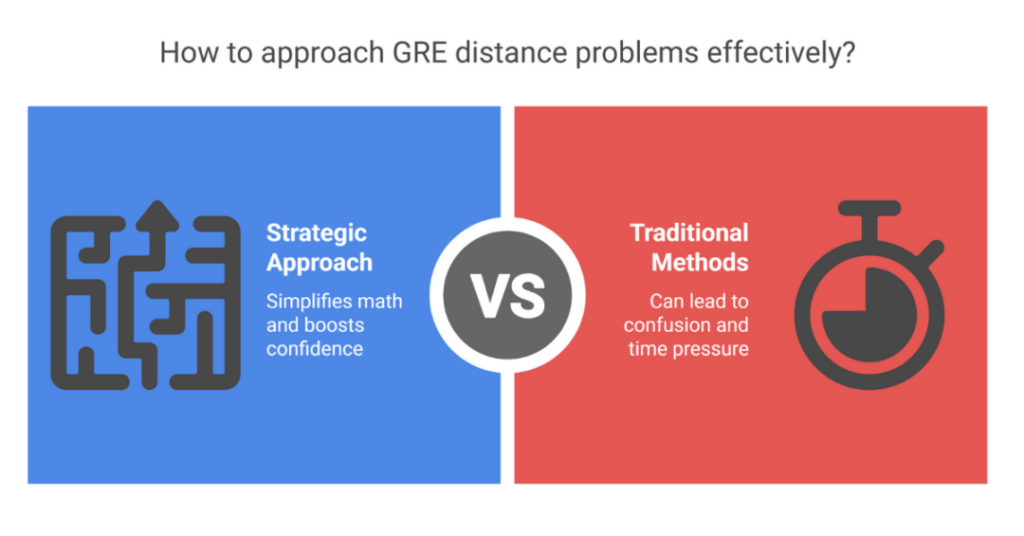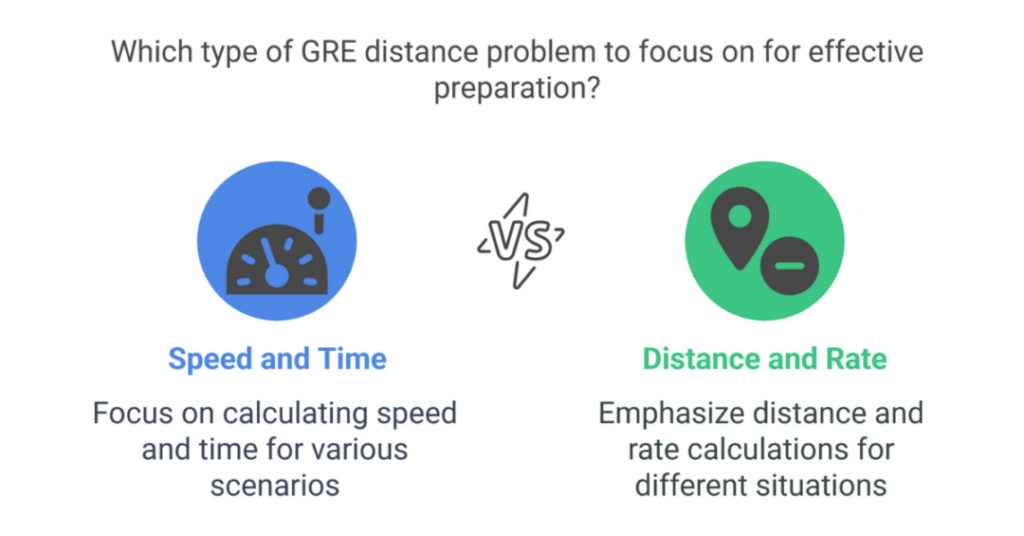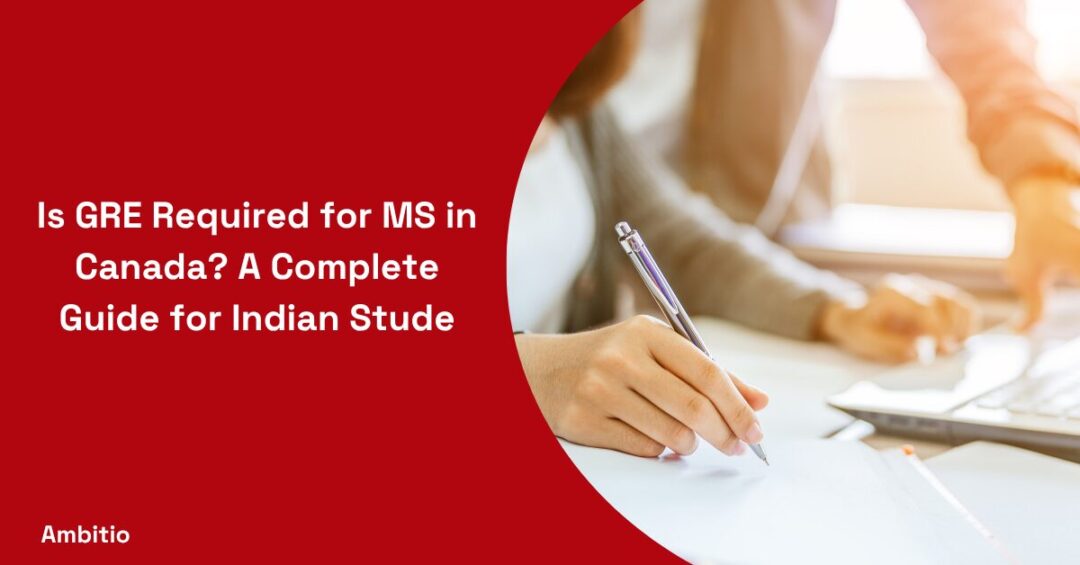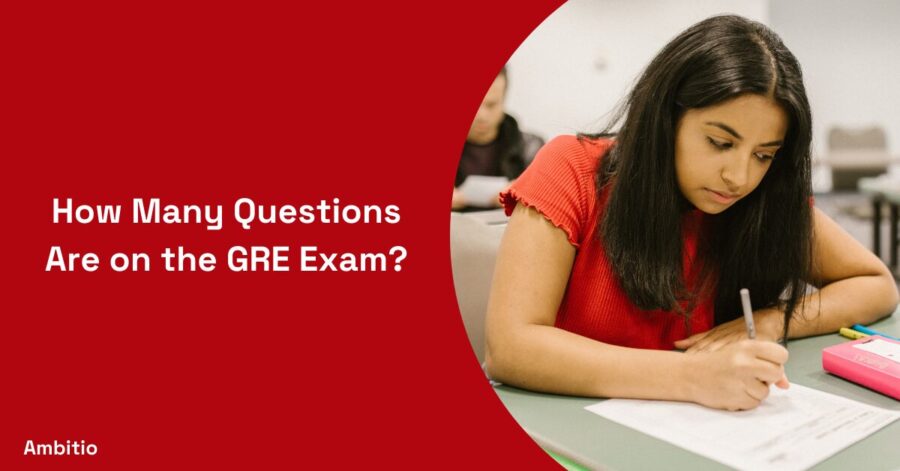13 June 2025
6 minutes read
GRE Distance Problems: Time and Speed GRE® Quant Questions for Indian Students

Key Takeaways
- Master GRE distance problems by simplifying formulas and focusing on applying them efficiently under timed conditions.
- Break down complex GRE distance problems into smaller, manageable steps and use estimation to save time while still getting closer to the correct solution.
- Regular timed practice is essential to boost both your speed and confidence with the GRE distance problems, helping you tackle all problems with ease.
Conquering GRE quantitative distance questions can be like wading through quicksand. The mathematics—be it average speed, relative speed, or calculating total distance travelled—usually catches individuals off guard, particularly if time is of the essence.
It’s simple to get distracted when mph and km begin to get confused, and test pressure certainly further confounds the situation.
But here’s the good news: these kinds of problems don’t necessarily have to destroy you. With the right strategy, you can even break “find the distance” questions when they try to make you nuts.
In this blog, we’re going to demystify some practical tips to make math easier and get you through these types of problems quicker. By the time you’re done, you’ll feel a lot better heading into your next quant section. And of course, we will end with a bonus practice question to warm you up.
What Are GRE Quant Speed Distance and Time Word Problems?
GRE quant distance problems are a big part of the test’s speed and distance section, and they come in many forms. You might face questions about a man traveling between two cities, covering a distance at a speed of 30 mph, or a cyclist who takes 2.5 hours to travel at a speed of 10 mph.

The goal is usually to find the total distance, the time taken to complete the trip, or the average speed for the entire journey. These problems are designed to test your understanding of how distance, speed, and time work together.
For example, you might need to figure out the time taken for the first part of a trip when a car is traveling at a speed of 60 mph.
Or you could face a scenario where two objects are moving in opposite directions—like trains covering the same distance, one at a speed of 80 mph and the other at 60 mph—and you have to calculate how long it will take for them to meet.
So, whether it’s finding the remaining distance in a journey, solving speed problems involving different stages, or dealing with quantities like 50 and 75 meters per second, the GRE exam quant section demands clear thinking and practice with these kinds of problems.
6 GRE Speed Distance Problems Practice Questions
Speed and distance problems are some of the most common types of questions in the GRE quant section. These problems test your ability to apply basic formulas for distance, speed, and time to different scenarios.
By practicing these questions, you’ll get better at solving them quickly and accurately—something that’s crucial for a timed test like the GRE exam, which can be achieved through effective GRE prep.
Below, you’ll find six practice questions to help you sharpen your skills:
1. A cyclist travels at a speed of 15 mph for 2.5 hours. How far did the cyclist travel?
Answer:
Distance = Speed × Time
Distance = 15 mph × 2.5 hours = 37.5 miles
2. A train leaves City A at a speed of 60 mph. Two hours later, a second train leaves City A at a speed of 80 mph. How long will it take for the second train to catch up with the first?
Answer:
Let ttt be the time taken by the second train to catch up.
The first train travels for t+2t + 2t+2 hours.
Distance covered by both trains is the same, so:
60(t+2)=80t60(t + 2) = 80t60(t+2)=80t
60t+120=80t60t + 120 = 80t60t+120=80t
20t=12020t = 12020t=120
t=6t = 6t=6 hours.
So, the second train will catch up in 6 hours.
3. A boat’s speed in still water is 12 mph, and the speed of the stream is 3 mph. How long does it take for the boat to travel 24 miles upstream?
Answer:
Effective speed upstream = Boat’s speed – Stream’s speed
Effective speed = 12 mph – 3 mph = 9 mph
Time = Distance ÷ Speed
Time = 24 miles ÷ 9 mph = 2.67 hours (or approximately 2 hours and 40 minutes)
4. A car travels from City X to City Y at a speed of 50 mph and returns from City Y to City X at a speed of 75 mph. Find the average speed for the entire trip.
Answer:
Let the distance between City X and City Y be ddd.
Time taken to travel from X to Y = d50\frac{d}{50}50d
Time taken to travel from Y to X = d75\frac{d}{75}75d
Total distance = 2d2d2d
Total time = d50+d75=5d150\frac{d}{50} + \frac{d}{75} = \frac{5d}{150}50d+75d=1505d
Average speed = Total distance ÷ Total time
Average speed = 2d5d150=25150=60\frac{2d}{\frac{5d}{150}} = \frac{2}{\frac{5}{150}} = 601505d2d=15052=60 mph
So, the average speed for the entire trip is 60 mph
5. Two runners, A and B, are 20 miles apart and run towards each other at speeds of 8 mph and 6 mph, respectively. How long will it take them to meet?
Answer:
Relative speed = 8 mph + 6 mph = 14 mph (22.5 kmph)
Time = Distance ÷ Speed
Time = 20 miles ÷ 14 mph = 1.43 hours (or approximately 1 hour and 26 minutes)
6. A man travels 20 km in 4 hours. He covers the first 10 km at a speed of 2.5 km/h. What is his speed for the remaining distance?
Answer:
Time taken for the first part of the journey = 102.5=4\frac{10}{2.5} = 42.510=4 hours
Total time = 4 hours
Time remaining for the second part of the journey = 4 – 4 = 0 hours
But this seems incorrect since it would suggest no time was left, so let’s redo with updated details.
4 Expert Tips To Solve GRE Quant Questions
So, here’s what you actually need—expert advice to crack GRE quant questions with ease. Whether you’re struggling with algebra, geometry, or those tricky word problems, having a solid strategy can make all the difference.

Here are four expert tips that will help you sharpen your skills and approach the GRE quant section with confidence.
1. Master the Basics of Formulas and Concepts
Before diving into practice questions, ensure you’re familiar with the core formulas, like those for distance, speed, time, and common algebraic equations.
Many GMAT, IELTS, TOEFL, SAT, ACT and GRE questions are built around basic concepts, and being comfortable with these will allow you to solve problems more efficiently. Revisit key areas like ratios, percentages, and geometry—these appear frequently in GRE quant.
2. Break Down Complex Problems Into Simpler Parts
Many GRE quant questions are designed to appear more complicated than they actually are. One expert trick is to break down complex problems into smaller, more manageable parts.
For example, if a question involves multiple steps, focus on solving one piece at a time. This can help eliminate confusion and keep your calculations on track.
3. Use Estimation When Necessary
In timed exams like the GRE, precision is important, but sometimes estimation can save you valuable minutes. If you’re stuck on a question, try approximating the answer first.
This can often help you eliminate wrong answer choices and get you closer to the correct solution without getting bogged down in complicated math.
4. Practice Under Timed Conditions
One of the biggest challenges in the GRE quant section is managing time. Even if you know how to solve the questions, you need to be able to do it quickly.
Make sure to practice with a timer to simulate real exam conditions. This will help you gauge how much time you should be spending on each question and avoid rushing through the test.
Pro tip: You can add this test score in your statement of purpose, personal statement, letter of recommendation and your resume as well.
Conclusion
At the end of the day, GRE quant distance problems are just puzzles waiting to be solved. They might seem tricky, but once you break them down and practice regularly, they start to feel a lot more manageable.
The key is to keep things simple—understand the basics, tackle problems step-by-step, and keep an eye on the clock.
Remember, even the toughest problems can be cracked with a calm mind and a strategic approach. Focus on mastering the core concepts, use estimation to your advantage when needed, and most importantly, practice under real exam conditions.
You’ve got this! With the right preparation, these problems will become just another hurdle you’re more than capable of overcoming on your path to GRE success.
Ambitio’s GRE Bootcamp Tailors Your Path to Excellence! Benefit from a customized prep experience that adapts to your strengths and weaknesses, maximizing your score potential.
FAQs
What are GRE distance problems and why are they important?
GRE distance problems are quantitative reasoning questions that test your understanding of speed, time, and distance relationships—key concepts for scoring well in the GRE math section.
How do I approach solving GRE distance problems effectively?
To solve GRE distance problems, use the formula Distance = Speed × Time, and pay close attention to unit conversions and question traps.
Are GRE distance problems time-consuming during the exam?
Some GRE distance problems can be time-consuming if not approached methodically, so practice is crucial to improve speed and accuracy.
Where can I practice GRE distance problems online?
You can practice GRE distance problems on platforms like ETS PowerPrep, Manhattan Prep, Magoosh, and other test prep websites offering problem-specific drills.
What math concepts are essential for mastering GRE distance problems?
To master GRE distance problems, you must understand ratios, algebraic equations, relative speed, and unit conversions.
Do GRE distance problems appear in both Quant sections of the GRE?
Yes, GRE distance problems may appear in either or both Quantitative sections, especially in the Problem Solving and Quantitative Comparison question formats.
Can GRE distance problems involve trains, boats, or planes?
Absolutely. GRE distance problems often feature real-life scenarios involving trains, boats, or planes to test concepts like relative speed and directional motion.

You can study at top universities worldwide!
Get expert tips and tricks to get into top universities with a free expert session.
Book Your Free 30-Minute Session Now! Book a call now




























